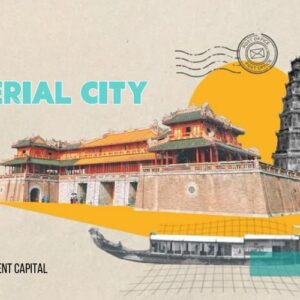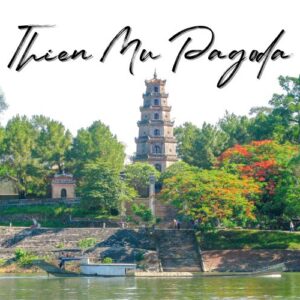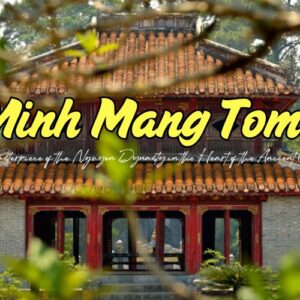
Hue Imperial City is not only a popular tourist destination but also a place that preserves the golden imprints of the Nguyen Dynasty, the last feudal dynasty of Vietnam. Suppose you are a history lover, passionate about ancient architecture, or simply want to immerse yourself in the quiet space of the ancient capital. In that case, Hue Imperial City is definitely a destination not to be missed. Read this article to get comprehensive information about this beautiful attraction in Hue.
Historical information about Hue Imperial City
The history of Hue Imperial City is closely associated with the establishment and development of the Nguyen Dynasty. When Gia Long King ascended the throne in 1802, he decided Hue to be the capital city for the reason that this is the center of the country for both military convenience and feng shui purposes. The building took nearly 30 years, starting under the rule of King Gia Long in 1805 and completed under the rule of King Minh Mang in 1832.
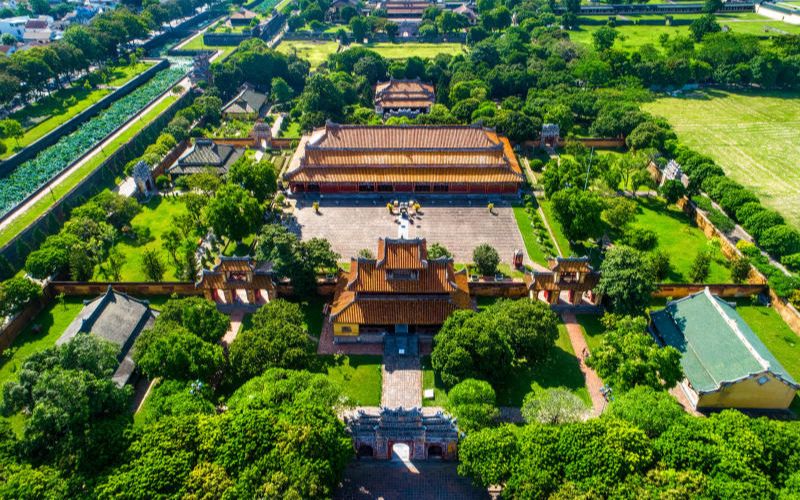
An overview of Hue Imperial City
If you have heard about the Forbidden City in Beijing or Gyeongbokgung Palace in Korea, then the Hue Imperial Citadel is also a compatible architectural feature that presents a rich Vietnamese heritage. However, the special thing about Hue Imperial City is that it is majestic or flashy, but elegant and silent like an ink painting.
Over time, Hue Imperial City has experienced many historical upheavals, from the glorious days of the Nguyen Dynasty to devastating wars, with many buildings destroyed. Nevertheless, it remains an eternal symbol of Vietnamese culture.
The structure of Hue Imperial City
The unique feature of Hue Imperial City is not only its massive scale but also the subtle combination of almost square in shape, surrounded by approximately 10 kilometers of city walls and deep water moats, which is a defense inspired by the French Vauban model.
However, when walking inside, you will find a different world, a space full of Eastern style, with palaces, temples, and tomb systems strictly arranged according to feng shui principles. The king resides in the middle of the Citadel; in front is the Huong River, like a soft silk strip bringing vitality, and behind is Ngu Binh Mountain as a solid support. It is interesting to view the Truong Tien Bridge as the mark of two sides of the city, each with its own characteristic. While the side of Hue Imperial City has the historical and nostalgic beauty, the other has the modern and bustling charm.
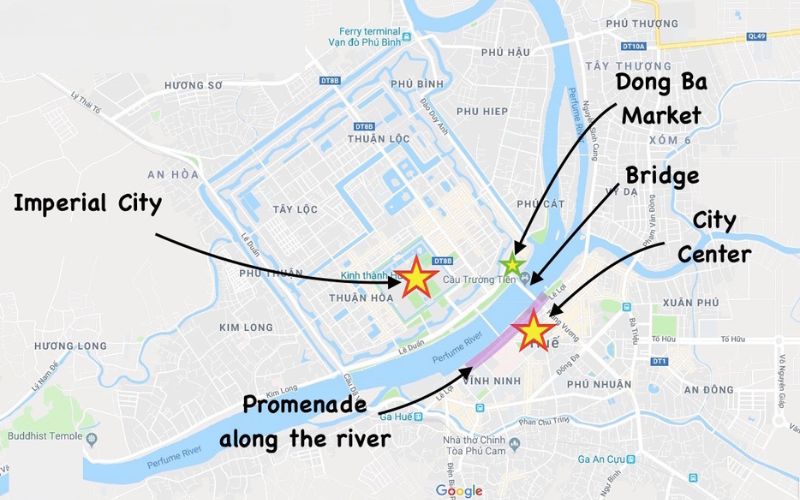
Where is Hue Imperial City on the map?
The Hue Imperial City is divided into three main areas. Here is the detailed description so that you can get the complete of Hue Imperial Citadel:
The Capital Citadel (outer ring)
The Imperial City is the outermost citadel, acting as a solid defensive wall protecting the entire central area of the royal court. Built according to the Western Vauban military principles, the Citadel has a nearly square shape with a total area of about 520 hectares. The entire wall system is about 10 km long, 6-8 m high, built of solid bricks and stones, and surrounded by a wide moat, which regulates water from the Perfume River.
The Citadel has 10 main gates, each with meaningful names such as Ngan Gate, Huu Gate, Chanh Tay Gate, and Thuong Tu Gate, with bridges across the moat for easy access. This is also where the royal court’s administrative agencies, military barracks, and residential houses are located. Walking along the citadel, you will cross forts, watchtowers, and cannons lining the ramparts. One of the highlights is the Hue Flag Tower, located to the south of the Citadel, where the royal flag was once flown and witnessed many important historical events, especially on August 30, 1945, when King Bao Dai abdicated.
The Imperial City (middle ring)
Passing through Ngo Mon Gate, you will set foot in the Imperial City, the most important area of Hue Imperial Citadel. The Imperial City is surrounded by a solid wall, with a total of 4 main gates, of which Ngo Mon Gate is the most important one.
Inside the Imperial City is a system of palaces, temples, and communal houses arranged along the main North-South axis, with Thai Hoa Palace as the center. There are also many other important structures, such as The Mieu, Hien Lam Cac, and Dien Tho Palace.
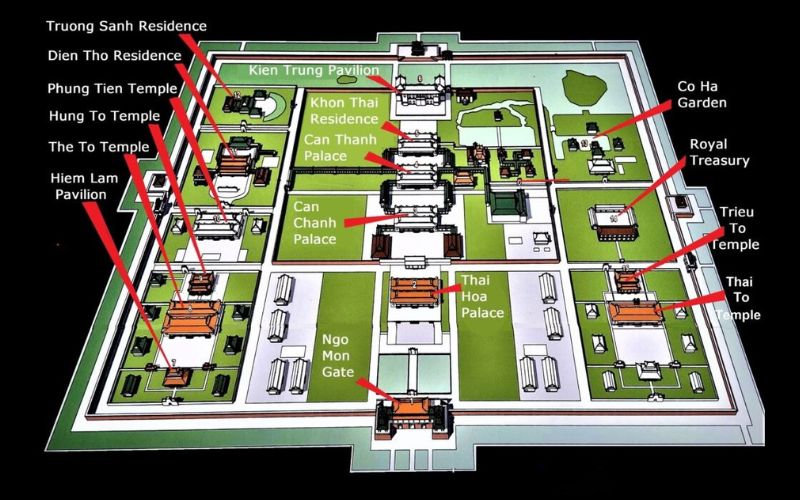
Hue Imperial City travel map
The Forbidden Purple City (inner ring)
The Forbidden Purple is the deepest area in the Imperial City, reserved for the king and the royal family. If the Imperial City is the political center, the Forbidden City is the private space of the emperor.
Surrounded by a wall about 3.5 m thick, the Forbidden City has only 7 entrances, of which Dai Cung Mon is the main gate, reserved for the king and queen. Inside, the system of palaces and towers is arranged symmetrically, creating an architectural complex that is both solemn and peaceful. There are several typical works in the Forbidden City, such as Khun Thai Palace, Truong Sanh Palace, Ta Vu and Ha Vu, which are the workplaces of officials in the Imperial City.
Unfortunately, due to the war and time, many of the buildings in the Forbidden City have been destroyed. However, the remaining ruins still show the splendor of a golden age. When you step inside, you will feel an unusually quiet space, as if each brick and each roof tile still preserve stories of the past.
Where to Go in Hue Imperial City?
With the large scale, a whole day strolling around Hue Imperial City is still not enough to explore all the corners of it. Here are the most outstanding destinations that you cannot miss.
Ngo Mon: The Powerful Gate of the Imperial City
Ngo Mon is not only the entrance to the Imperial City but also the place where important events take place. The feeling when you step through the Ngo Mon gate is like going through a time door, returning to the golden age of the Nguyen Dynasty. Take some time to stand on the Ngu Phung floor, where the emperors used to observe the court ceremonies, to feel the majestic atmosphere of this space.
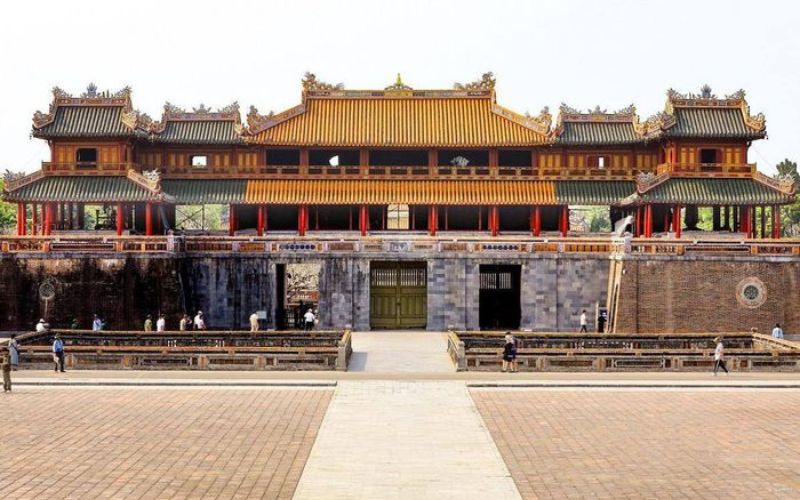
Ngo Mon
Thai Hoa Palace: The Heart of Hue Imperial City
If Ngo Mon is the gate, then Thai Hoa Palace is the soul of Hue Imperial City. This is the place where the king holds court, where he witnesses solemn court sessions. The palace’s architecture stands out with rows of ironwood pillars carved with dragons and phoenixes and a splendid golden glazed tile roof. Standing in the palace, you can imagine the solemn atmosphere when the king sits on the throne; in front of him are high-ranking mandarins in formal court attire.
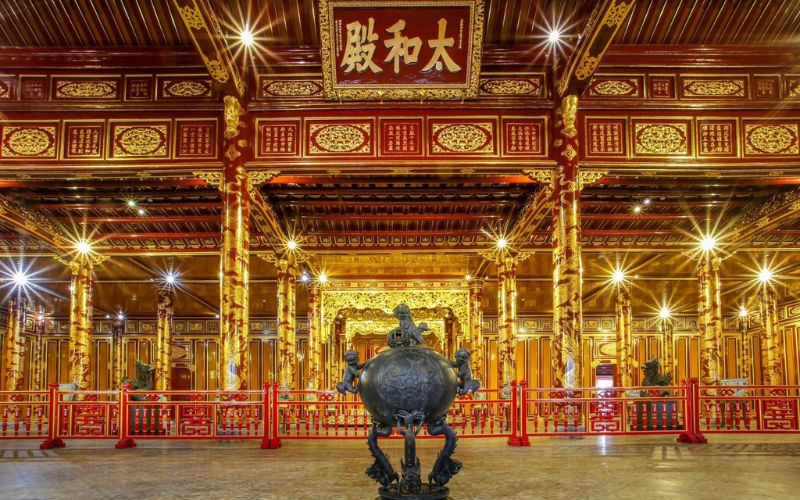
The flashy beauty inside Thai Hoa Palace
The Temple: The Place Marking the 13 Nguyen Kings
A solemn place where the descendants of the royal family come to burn incense and pay tribute to their ancestors. Along both sides of The Temple of the Nguyen King’s yard are rows of stone statues, creating a sacred and quiet space. If you love history, this is the place to help you understand more about each Nguyen Dynasty king and the mark they left behind.

The Mieu, the place marking the 13th Nguyen King
Hien Lam Cac: The tallest building in the Imperial Citadel
If the Imperial City had a “tower,” it would be Hien Lam Cac. This is the tallest building in the Nguyen Dynasty, built to honor the meritorious mandarins. It is worth noting that no building in the palace is allowed to be higher than this point, which shows respect for the work of ancestors. If you want to admire the best view of Hue Imperial Citadel, just climb to Hien Lam Cac. From here, you can see the whole Imperial structure, from Ngo Mon Gate to the palaces; it’s feels like looking at the past of the Nguyen Dynasty from a broader perspective.
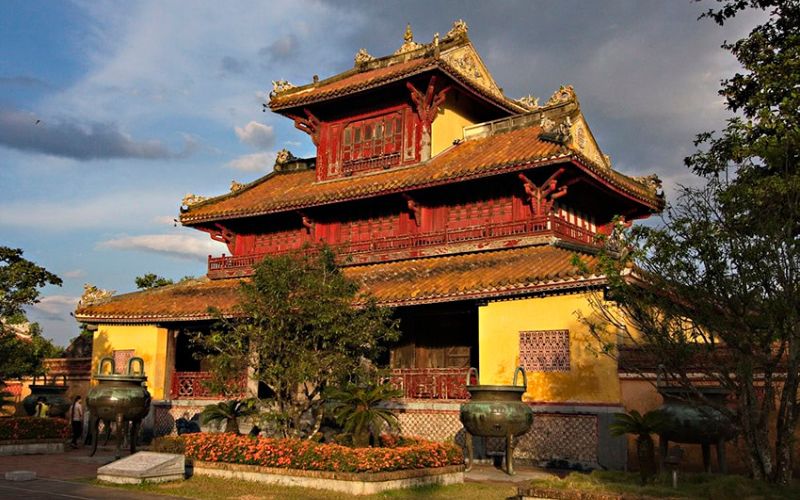
Hien Lam Cac, the tallest building in Hue Imperial City
Dien Tho Palace: The Peaceful Place of the Queen Mother
Dien Tho Palace is a place reserved for the Queen Mother (mother of the King). This is not only a place to live, but also a separate space for the queen mother to rest, pray, and relax. Compared to other magnificent palaces, Dien Tho Palace has a more peaceful beauty. The campus has a lake, green trees, and moss-covered porches, all creating a peaceful atmosphere. Coming here, try to find a quiet corner, listen to the birds chirping, and feel the cool air of the garden, and you will understand why this place used to be a resting place for the mothers of the world.
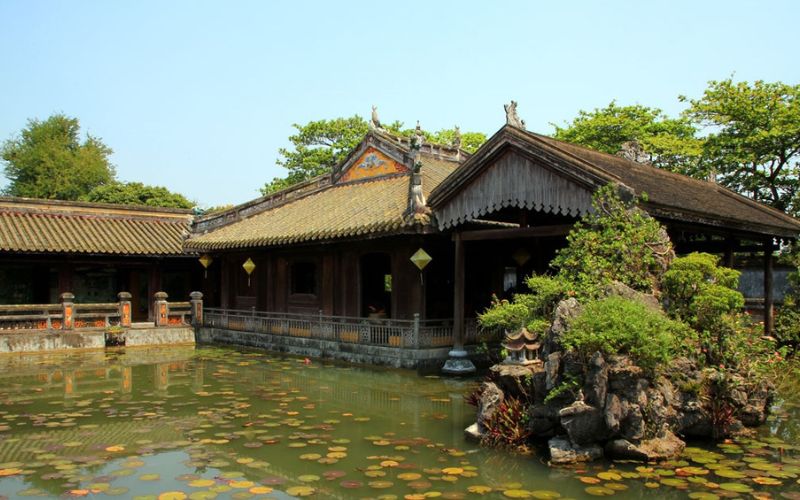
Dien Tho Palace, the peace palace of the Queen Mother
Helpful Information for Visitors
Hue Imperial Citadel is a UNESCO-recognized site in Vietnam and an unmissable destination when visiting Hue. However, for the first time visit, Hue Imperial Citadel might confuse visitors with its scale and a large number of buildings, temples, and palaces. Knowing this concern, we provide you with some helpful tips below:
The best time to visit
It is fair to say that Hue is beautiful all year round, but if you want to enjoy the pleasant air and avoid the rain, you should go from January to April. This is when the weather is cool and dry, suitable for exploring the vast imperial city. If you come in the summer (May to August), remember to wear hats, caps, and water because the weather is scorching hot. From September to December, Hue often experiences rain; therefore, you should bring a raincoat or umbrella.
What to wear?
Although it is not mandatory, this is a historical place; therefore, you should show respect by wearing polite and covered clothes. Moreover, you will walk through the large scale of Hue Imperial Citadel; it is recommended to wear sneakers or flat sandals. If you want to take beautiful photos, choose traditional Ao Dai or nostalgic clothes to blend into the old space.
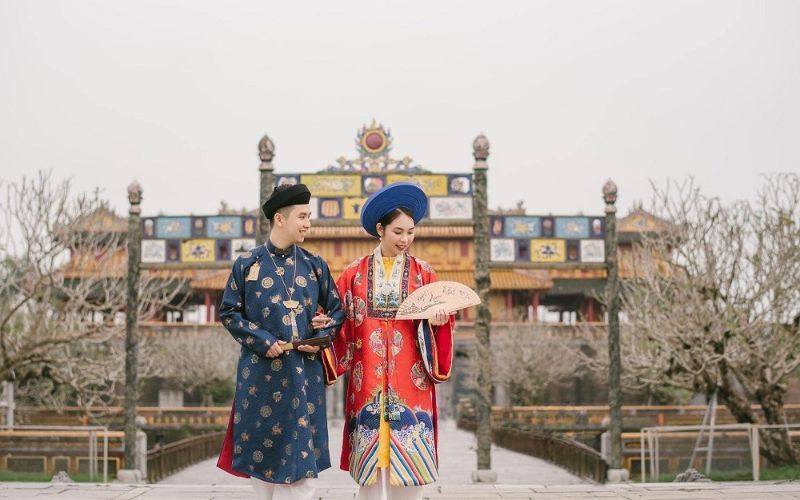
Taking photo at Hue Imperial City with Ao Dai/Ancient Cloth
Ticket and Visit itinerary
There are many types of tickets to visit Hue Imperial City, the most popular being the combo ticket to visit the Imperial City, Khai Dinh Tomb, and Minh Mang Tomb… Ticket prices may change over time, so you can check before going. The Citadel is very large, so if you are going for the first time, you can follow the following schedule:
- Ngo Mon Gate: The main entrance to the Imperial City, which is associated with many historical events.
- Thai Hoa Palace: Where the King held court, with magnificent architecture.
- The Mieu & Hien Lam Cac: Places to worship the kings of the Nguyen Dynasty.
- Dien Tho Palace: Area for the Queen Mother with elegant architecture.
- Forbidden Purple City: The living area of the king and the royal family, although not interactive now, is still worth exploring.
What to eat around Hue Imperial City?
If you are a foodie, Hue is absolutely food heaven! Around the Hue Imperial City, you’ll find a variety of local dishes that reflect Hue’s rich culinary heritage. Here’s a breakdown of some must-try foods and where to find them:
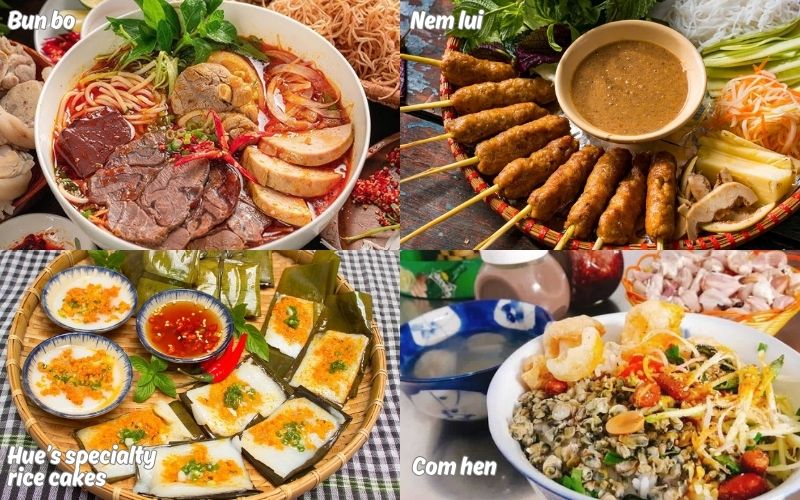
Hue local cuisines
Bun Bo Hue (Hue Beef Noodle Soup)
A signature dish of Hue, bun bo Hue is known for its bold broth, infused with lemongrass, chili, and shrimp paste, served with beef, pork, and fresh herbs.
Where to try: Bun bo Hue O Phuong (24 Nguyen Khuyen, near the Citadel) and Bun bo Me Keo (20 Bach Dang, a traditional street-side eatery)
Com Hen (Clam Rice)
This is a humble but flavorful dish made with rice (or vermicelli), baby clams, peanuts, crispy pork skin, and a mix of fresh herbs.
Where to try: Com Hen Hoa Dong (7 Ung Binh, near Com Hen Islet) and Com Hen 26 (26 Truong Dinh, close to the Citadel).
Banh Beo, Banh Nam, Banh Loc (Hue’s Specialty Rice Cakes)
These small steamed rice cakes are served with shrimp paste, crispy shallots, and fish sauce.
Where to try: Quan Ba Do (8 Nguyen Binh Khiem, a famous spot for Hue cakes) and Quan Hang Me Me (12 Vo Thi Sau, offering a full selection of Hue’s specialty cakes).
Nem Lui (Hue-style Lemongrass Skewers)
This is grilled minced pork skewered on lemongrass sticks, served with fresh herbs and rice paper.
Where to try: Quan Hanh (11 Pho Duc Chinh, known for authentic nem lui) and Quan Ty Nem Lui (81 Dao Duy Tu, a local favorite).
In conclusion, Hue Imperial City is a must-visit destination during your vacation in Hue. With its ancient historical buildings and tranquil atmosphere, this place allows people to slow down and trace back to the past, then be more respectful to their history and grateful for their presence. If you are in love with the charm of Hue Imperial City, please contact us and let us be your companion in your adventure here.
Read more:

